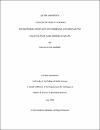ANTIMICROBIAL RESISTANCE OF COMMENSAL ESCHERICHIA COLI ISOLATED FROM FOOD ANIMALS IN QATAR
| المرشد | Yassine, Hadi Mohamad |
| المؤلف | ALHABABI, DALAL ALI |
| تاريخ الإتاحة | 2019-07-30T04:50:56Z |
| تاريخ النشر | 2019-06 |
| الملخص | Background: The dissemination of antimicrobial resistance (AMR) bacteria is associated with the inappropriate use of antibiotics in both humans and animals. In particular, the use of antibiotics for prophylactic and growth promotion purposes in food-producing animals, in addition to animal-group medication for prolonged times, have rendered many of the antibiotics ineffective, returning us to the old times when a simple infection could be deadly. Objectives: This study aims at evaluating the incidence of AMR in Qatar under the one health approach; i.e., human-animal-environmental interface. Specifically, we aim to characterize the phenotypic and genotypic AMR pattern of 18 clinically relevant antibiotics in major food-producing animals. Ultimately, we aim to compare our findings to the data released by the monitoring programs in Hamad Medical Corporation (HMC) along with previously published reports from Qatar. Methods: Animal fecal samples from camels, cattle, and pigeons (100 samples from each species) were collected from slaughterhouses and farms distributed in different locations in Qatar. One gram of fecal sample was vigorously homogenized with 3 ml sterile Phosphate Buffered Saline (PBS), the suspension was streaked directly onto chromogenic Tryptone Bile X-glucuronide agar for E. coli detection. Single typical E. coli colonies (blue-green) were randomly selected and streaked onto MacConkey agar plates and then recovered on nutrient agar plates for lactose fermentation testing by indole spot. The antibiotic susceptibility test was conducted using a Kirby-Bauer disk diffusion assay on Mueller-Hinton agar plates. Results: A total recovery rate of 88.7% (n=266) achieved from all samples. Overall, E. coli isolates had resistance to ten antibiotics in pigeon group, eight antibiotics in cattle group and only five antibiotics in camel group. Resistance to at least one antibiotic was recorded in 63 E. coli isolates (70.7%) from pigeons, 32 isolates (37.2%) from cattle and only in 19 isolates (20.8%) from camels. Multi-drug resistant (MDR) was highest in isolates from pigeons reaching 50% (n=44), followed by isolates from cattle (7%) and camels (2.2%). Highest resistance rate was observed against tetracycline, reaching a frequency of 64%, 27.9% and 15% of isolates from pigeons, cattle and camels, respectively (p <0.0001). Moreover, trimethoprim/sulfamethoxazole (an antibiotic used to treat a variety of bacterial infections) resistance was present in 22.2% (n=59) of all E. coli isolates, with the highest prevalence in pigeons (49.4%), followed by 11.6% in cattle and 5% in camels. Interestingly, one E. coli isolate from pigeon showed resistance to colistin, a drug of last resort in human medicine against gram-negative bacterial infection. Conclusions: We previously reported high multi-drug resistance of commensal E. coli in chickens, with significant resistance to colistin. We observed lower AMR profile in ruminants, presumably due to the different antibiotics used in the two animal industries. Nonetheless, the high resistance profile observed in pigeons (70.7%), including high multidrug resistance (50%) is alarming, as these animals could rapidly disseminate resistant bacteria to various locations. Interestingly, no ESBL producing E. coli reported. Nonetheless, continuous monitoring of AMR in livestock animals in Qatar is necessary toward introducing antimicrobial stewardship program and control of antibiotics usage in the veterinary sector. |
| اللغة | en |
| الموضوع | antimicrobial resistance (AMR) antibiotics antimicrobial stewardship |
| النوع | Master Thesis |
| التخصص | Biomedical Sciences |
الملفات في هذه التسجيلة
هذه التسجيلة تظهر في المجموعات التالية
-
العلوم الحيوية الطبية [66 items ]


